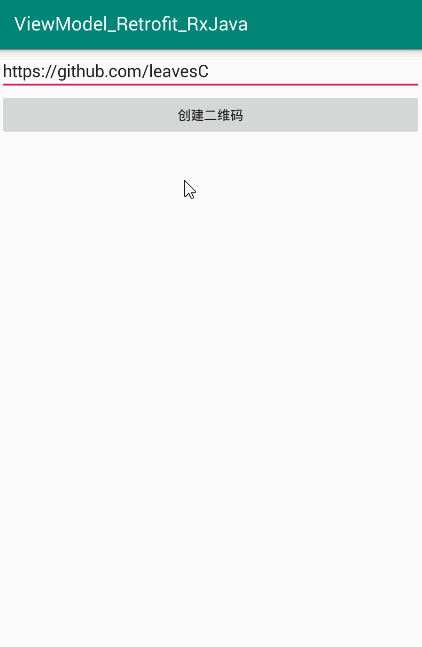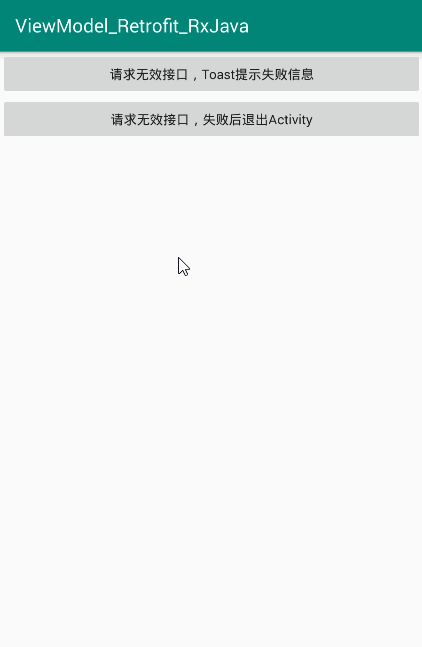一、前言
现如今 Android 领域流行的网络请求框架基本都是用 Retrofit 加 RxJava 来搭配构建的,而以 ViewModel + LiveData + Retrofit + RxJava 来构建请求框架的例子要相对少得多。而本文就是以这四者作为基础组件,介绍如何一步步封装实现自己的网络请求框架(本文实现的例子不仅仅只是一个网络请求框架,同时也是在介绍应用的架构模式),希望对你有所帮助
目前已实现的功能或者说特色包含以下几点:
1、网络请求结果基于观察者模式进行传递,回调操作与 UI 层的生命周期相绑定,避免了内存泄漏
2、数据加载时的 startLoading 与加载结束后的 dismissLoading 操作都是自动调用的,具体实现都封装在基类中。当然,子类也可以实现自己的特定实现。例如,本文提供的例子中,BaseActivity 实现的加载对话框是 ProgressDialog ,子 Activity 可以自主实现其他弹窗形式
3、当网络请求结果为非成功状态时(网络请求失败或者业务请求失败),默认操作是用 Toast 提示失败原因,支持自定义实现失败时的操作
4、逻辑操作与 UI 层相分离,基于观察者模式来实现消息驱动 UI 变化。提供了在 ViewModel 中操作 UI 变化的能力,包括使 Activity / Fragment 弹出对话框、Toast 消息、finishActivity 等 UI 操作,但 ViewModel 不持有 Activity / Fragment 的引用,而是基于消息驱动实现,从而避免了内存泄漏
源码点击这里查看:ReactiveHttp
二、封装 BaseViewModel 与 BaseActivity
ViewModel 与 LiveData 都是 Android Jetpack 架构组件之一。ViewModel 被设计用来存储和管理 UI 相关数据,以便数据能在界面销毁时(比如屏幕旋转)保存数据,而与 ViewModel 相挂钩的 LiveData 是一个用于保存可以被观察的值的数据持有类,且遵循应用组件的生命周期,只有在组件的生命周期处于活跃状态时才会收到数据更新通知
既然是消息驱动,那么自然需要一个用于抽象消息类型的 Event 类
/**
* 作者:leavesC
* 时间:2018/9/30 22:17
* 描述:
* GitHub:https://github.com/leavesC
*/
public class BaseEvent {
private int action;
public BaseEvent(int action) {
this.action = action;
}
public int getAction() {
return action;
}
}
public class BaseActionEvent extends BaseEvent {
public static final int SHOW_LOADING_DIALOG = 1;
public static final int DISMISS_LOADING_DIALOG = 2;
public static final int SHOW_TOAST = 3;
public static final int FINISH = 4;
public static final int FINISH_WITH_RESULT_OK = 5;
private String message;
public BaseActionEvent(int action) {
super(action);
}
public String getMessage() {
return message;
}
public void setMessage(String message) {
this.message = message;
}
}
BaseActionEvent 即用于向 View 层传递 Action 的 Model,在 ViewModel 通过向 View 层传递不同的消息类型,从而触发相对应的操作。因此,BaseViewModel 需要向子类提供默认的实现
public interface IViewModelAction {
void startLoading();
void startLoading(String message);
void dismissLoading();
void showToast(String message);
void finish();
void finishWithResultOk();
MutableLiveData<BaseActionEvent> getActionLiveData();
}
/**
* 作者:leavesC
* 时间:2018/9/30 22:24
* 描述:
* GitHub:https://github.com/leavesC
*/
public class BaseViewModel extends ViewModel implements IViewModelAction {
private MutableLiveData<BaseActionEvent> actionLiveData;
protected LifecycleOwner lifecycleOwner;
public BaseViewModel() {
actionLiveData = new MutableLiveData<>();
}
@Override
public void startLoading() {
startLoading(null);
}
@Override
public void startLoading(String message) {
BaseActionEvent baseActionEvent = new BaseActionEvent(BaseActionEvent.SHOW_LOADING_DIALOG);
baseActionEvent.setMessage(message);
actionLiveData.setValue(baseActionEvent);
}
@Override
public void dismissLoading() {
actionLiveData.setValue(new BaseActionEvent(BaseActionEvent.DISMISS_LOADING_DIALOG));
}
@Override
public void showToast(String message) {
BaseActionEvent baseActionEvent = new BaseActionEvent(BaseActionEvent.SHOW_TOAST);
baseActionEvent.setMessage(message);
actionLiveData.setValue(baseActionEvent);
}
@Override
public void finish() {
actionLiveData.setValue(new BaseActionEvent(BaseActionEvent.FINISH));
}
@Override
public void finishWithResultOk() {
actionLiveData.setValue(new BaseActionEvent(BaseActionEvent.FINISH_WITH_RESULT_OK));
}
@Override
public MutableLiveData<BaseActionEvent> getActionLiveData() {
return actionLiveData;
}
void setLifecycleOwner(LifecycleOwner lifecycleOwner) {
this.lifecycleOwner = lifecycleOwner;
}
}
那作为消息发送方的 BaseViewModel 的具体实现就完成了,之后是消息的接收方 BaseActivity / BaseFragment
BaseActivity 通过监听 BaseViewModel 中 actionLiveData 的数据变化从而在网络请求开始加载时 startLoading,在加载结束时 dismissLoading
一般一个 Activity 对应一个 ViewModel,少部分情况是会对应多个 ViewModel,因此 initViewModel() 声明为了抽象方法,而 initViewModelList() 默认返回了 null
/**
* 作者:leavesC
* 时间:2017/11/29 21:04
* 描述:
* GitHub:https://github.com/leavesC
*/
@SuppressLint("Registered")
public abstract class BaseActivity extends AppCompatActivity {
private ProgressDialog loadingDialog;
@Override
protected void onCreate(@Nullable Bundle savedInstanceState) {
super.onCreate(savedInstanceState);
initViewModelEvent();
}
protected abstract ViewModel initViewModel();
protected List<ViewModel> initViewModelList() {
return null;
}
private void initViewModelEvent() {
List<ViewModel> viewModelList = initViewModelList();
if (viewModelList != null && viewModelList.size() > 0) {
observeEvent(viewModelList);
} else {
ViewModel viewModel = initViewModel();
if (viewModel != null) {
List<ViewModel> modelList = new ArrayList<>();
modelList.add(viewModel);
observeEvent(modelList);
}
}
}
private void observeEvent(List<ViewModel> viewModelList) {
for (ViewModel viewModel : viewModelList) {
if (viewModel instanceof IViewModelAction) {
IViewModelAction viewModelAction = (IViewModelAction) viewModel;
viewModelAction.getActionLiveData().observe(this, baseActionEvent -> {
if (baseActionEvent != null) {
switch (baseActionEvent.getAction()) {
case BaseActionEvent.SHOW_LOADING_DIALOG: {
startLoading(baseActionEvent.getMessage());
break;
}
case BaseActionEvent.DISMISS_LOADING_DIALOG: {
dismissLoading();
break;
}
case BaseActionEvent.SHOW_TOAST: {
showToast(baseActionEvent.getMessage());
break;
}
case BaseActionEvent.FINISH: {
finish();
break;
}
case BaseActionEvent.FINISH_WITH_RESULT_OK: {
setResult(RESULT_OK);
finish();
break;
}
}
}
});
}
}
}
@Override
protected void onDestroy() {
super.onDestroy();
dismissLoading();
}
protected void startLoading() {
startLoading(null);
}
protected void startLoading(String message) {
if (loadingDialog == null) {
loadingDialog = new ProgressDialog(this);
loadingDialog.setCancelable(false);
loadingDialog.setCanceledOnTouchOutside(false);
}
loadingDialog.setTitle(message);
loadingDialog.show();
}
protected void dismissLoading() {
if (loadingDialog != null && loadingDialog.isShowing()) {
loadingDialog.dismiss();
}
}
protected void showToast(String message) {
Toast.makeText(this, message, Toast.LENGTH_SHORT).show();
}
protected void finishWithResultOk() {
setResult(RESULT_OK);
finish();
}
protected BaseActivity getContext() {
return BaseActivity.this;
}
protected void startActivity(Class cl) {
startActivity(new Intent(this, cl));
}
public void startActivityForResult(Class cl, int requestCode) {
startActivityForResult(new Intent(this, cl), requestCode);
}
@RequiresApi(api = Build.VERSION_CODES.JELLY_BEAN_MR1)
protected boolean isFinishingOrDestroyed() {
return isFinishing() || isDestroyed();
}
}
三、封装 Retrofit 与 RxJava
在前言中说了,框架默认实现了请求失败时的操作(Toast 提示失败原因),也支持自定义回调接口。因此,需要两个回调接口,一个只包含请求成功时的回调接口,另一个多包含了一个请求失败时的回调接口
/**
* 作者:leavesC
* 时间:2018/10/27 20:53
* 描述:
* GitHub:https://github.com/leavesC
*/
public interface RequestCallback<T> {
void onSuccess(T t);
}
public interface RequestMultiplyCallback<T> extends RequestCallback<T> {
void onFail(BaseException e);
}
此外,为了在网络请求成功但业务逻辑请求失败时(例如,请求参数缺失、Token失效等),可以抛出详细的失败信息,需要自定义 BaseException
public class BaseException extends RuntimeException {
private int errorCode = HttpCode.CODE_UNKNOWN;
public BaseException() {
}
public BaseException(int errorCode, String errorMessage) {
super(errorMessage);
this.errorCode = errorCode;
}
public int getErrorCode() {
return errorCode;
}
}
实现具体的异常类
public class ParamterInvalidException extends BaseException {
public ParamterInvalidException() {
super(HttpCode.CODE_PARAMETER_INVALID, "参数有误");
}
}
public class TokenInvalidException extends BaseException {
public TokenInvalidException() {
super(HttpCode.CODE_TOKEN_INVALID, "Token失效");
}
}
···
为了提升性能,Retrofit 一般是设计成单例模式。为了应对应用中 BaseUrl 可能有多个的情况(本文提供的Demo就是如此),此处使用 Map 来存储多个 Retrofit 实例
/**
* 作者:leavesC
* 时间:2018/10/26 23:11
* 描述:
* GitHub:https://github.com/leavesC
*/
public class RetrofitManagement {
private static final long READ_TIMEOUT = 6000;
private static final long WRITE_TIMEOUT = 6000;
private static final long CONNECT_TIMEOUT = 6000;
private final Map<String, Object> serviceMap = new ConcurrentHashMap<>();
private RetrofitManagement() {
}
public static RetrofitManagement getInstance() {
return RetrofitHolder.retrofitManagement;
}
private static class RetrofitHolder {
private static final RetrofitManagement retrofitManagement = new RetrofitManagement();
}
private Retrofit createRetrofit(String url) {
OkHttpClient.Builder builder = new OkHttpClient.Builder()
.readTimeout(READ_TIMEOUT, TimeUnit.MILLISECONDS)
.writeTimeout(WRITE_TIMEOUT, TimeUnit.MILLISECONDS)
.connectTimeout(CONNECT_TIMEOUT, TimeUnit.MILLISECONDS)
.addInterceptor(new HttpInterceptor())
.addInterceptor(new HeaderInterceptor())
.addInterceptor(new FilterInterceptor())
.retryOnConnectionFailure(true);
if (BuildConfig.DEBUG) {
HttpLoggingInterceptor httpLoggingInterceptor = new HttpLoggingInterceptor();
httpLoggingInterceptor.setLevel(HttpLoggingInterceptor.Level.BODY);
builder.addInterceptor(httpLoggingInterceptor);
builder.addInterceptor(new ChuckInterceptor(ContextHolder.getContext()));
}
OkHttpClient client = builder.build();
return new Retrofit.Builder()
.client(client)
.baseUrl(url)
.addConverterFactory(GsonConverterFactory.create())
.addCallAdapterFactory(RxJava2CallAdapterFactory.create())
.build();
}
<T> ObservableTransformer<BaseResponseBody<T>, T> applySchedulers() {
return observable -> observable.subscribeOn(Schedulers.io())
.unsubscribeOn(Schedulers.io())
.observeOn(AndroidSchedulers.mainThread())
.flatMap(result -> {
switch (result.getCode()) {
case HttpCode.CODE_SUCCESS: {
return createData(result.getData());
}
case HttpCode.CODE_TOKEN_INVALID: {
throw new TokenInvalidException();
}
case HttpCode.CODE_ACCOUNT_INVALID: {
throw new AccountInvalidException();
}
default: {
throw new ServerResultException(result.getCode(), result.getMsg());
}
}
});
}
private <T> Observable<T> createData(T t) {
return Observable.create(new ObservableOnSubscribe<T>() {
@Override
public void subscribe(ObservableEmitter<T> emitter) {
try {
emitter.onNext(t);
emitter.onComplete();
} catch (Exception e) {
emitter.onError(e);
}
}
});
}
<T> T getService(Class<T> clz) {
return getService(clz, HttpConfig.BASE_URL_WEATHER);
}
<T> T getService(Class<T> clz, String host) {
T value;
if (serviceMap.containsKey(host)) {
Object obj = serviceMap.get(host);
if (obj == null) {
value = createRetrofit(host).create(clz);
serviceMap.put(host, value);
} else {
value = (T) obj;
}
} else {
value = createRetrofit(host).create(clz);
serviceMap.put(host, value);
}
return value;
}
}
此外还需要一个自定义的 Observer 来对数据请求结果进行自定义回调
/**
* 作者:leavesC
* 时间:2018/10/27 20:52
* 描述:
* GitHub:https://github.com/leavesC
*/
public class BaseSubscriber<T> extends DisposableObserver<T> {
private BaseViewModel baseViewModel;
private RequestCallback<T> requestCallback;
public BaseSubscriber(BaseViewModel baseViewModel) {
this.baseViewModel = baseViewModel;
}
BaseSubscriber(BaseViewModel baseViewModel, RequestCallback<T> requestCallback) {
this.baseViewModel = baseViewModel;
this.requestCallback = requestCallback;
}
@Override
public void onNext(T t) {
if (requestCallback != null) {
requestCallback.onSuccess(t);
}
}
@Override
public void onError(Throwable e) {
e.printStackTrace();
if (requestCallback instanceof RequestMultiplyCallback) {
RequestMultiplyCallback callback = (RequestMultiplyCallback) requestCallback;
if (e instanceof BaseException) {
callback.onFail((BaseException) e);
} else {
callback.onFail(new BaseException(HttpCode.CODE_UNKNOWN, e.getMessage()));
}
} else {
if (baseViewModel == null) {
Toast.makeText(ContextHolder.getContext(), e.getMessage(), Toast.LENGTH_SHORT).show();
} else {
baseViewModel.showToast(e.getMessage());
}
}
}
@Override
public void onComplete() {
}
}
四、BaseRemoteDataSource 与 BaseRepo
上文所介绍的 RequestCallback、RetrofitManagement 与 BaseSubscriber 还是一个个单独的个体,还需要一个链接器来将之串起来,这个链接器的实现类即 BaseRemoteDataSource
在这里,对 BaseRemoteDataSource 的定位是将之当成一个接口实现者,即在 RemoteDataSource 中实际调用各个请求接口,并通过 RxJava 来控制 loading 弹出以及销毁的时机
一般而言,BaseRemoteDataSource 的实现类中声明的是具有相关逻辑的接口。例如,对于登录模块,可声明一个 LoginDataSource,对于设置模块,可以声明一个 SettingsDataSource
/**
* 作者:leavesC
* 时间:2018/10/27 7:42
* 描述:
* GitHub:https://github.com/leavesC
*/
public abstract class BaseRemoteDataSource {
private CompositeDisposable compositeDisposable;
private BaseViewModel baseViewModel;
public BaseRemoteDataSource(BaseViewModel baseViewModel) {
this.compositeDisposable = new CompositeDisposable();
this.baseViewModel = baseViewModel;
}
protected <T> T getService(Class<T> clz) {
return RetrofitManagement.getInstance().getService(clz);
}
protected <T> T getService(Class<T> clz, String host) {
return RetrofitManagement.getInstance().getService(clz, host);
}
private <T> ObservableTransformer<BaseResponseBody<T>, T> applySchedulers() {
return RetrofitManagement.getInstance().applySchedulers();
}
protected <T> void execute(Observable observable, RequestCallback<T> callback) {
execute(observable, new BaseSubscriber<>(baseViewModel, callback), true);
}
protected <T> void execute(Observable observable, RequestMultiplyCallback<T> callback) {
execute(observable, new BaseSubscriber<>(baseViewModel, callback), true);
}
public void executeWithoutDismiss(Observable observable, Observer observer) {
execute(observable, observer, false);
}
private void execute(Observable observable, Observer observer, boolean isDismiss) {
Disposable disposable = (Disposable) observable
.throttleFirst(500, TimeUnit.MILLISECONDS)
.subscribeOn(Schedulers.io())
.unsubscribeOn(Schedulers.io())
.observeOn(AndroidSchedulers.mainThread())
.compose(applySchedulers())
.compose(isDismiss ? loadingTransformer() : loadingTransformerWithoutDismiss())
.subscribeWith(observer);
addDisposable(disposable);
}
private void addDisposable(Disposable disposable) {
compositeDisposable.add(disposable);
}
public void dispose() {
if (!compositeDisposable.isDisposed()) {
compositeDisposable.dispose();
}
}
private void startLoading() {
if (baseViewModel != null) {
baseViewModel.startLoading();
}
}
private void dismissLoading() {
if (baseViewModel != null) {
baseViewModel.dismissLoading();
}
}
private <T> ObservableTransformer<T, T> loadingTransformer() {
return observable -> observable
.subscribeOn(AndroidSchedulers.mainThread())
.unsubscribeOn(AndroidSchedulers.mainThread())
.observeOn(AndroidSchedulers.mainThread())
.doOnSubscribe(disposable -> startLoading())
.doFinally(this::dismissLoading);
}
private <T> ObservableTransformer<T, T> loadingTransformerWithoutDismiss() {
return observable -> observable
.subscribeOn(AndroidSchedulers.mainThread())
.unsubscribeOn(AndroidSchedulers.mainThread())
.observeOn(AndroidSchedulers.mainThread())
.doOnSubscribe(disposable -> startLoading());
}
}
除了 BaseRemoteDataSource 外,还需要一个 BaseRepo。对 BaseRepo 的定位是将其当做一个接口调度器,其持有 BaseRemoteDataSource 的实例并中转 ViewModel 的接口调用请求,并可以在 BaseRepo 分担一部分数据处理逻辑
/**
* 作者:leavesC
* 时间:2018/10/27 21:10
* 描述:
* GitHub:https://github.com/leavesC
*/
public class BaseRepo<T> {
protected T remoteDataSource;
public BaseRepo(T remoteDataSource) {
this.remoteDataSource = remoteDataSource;
}
}
这样,ViewModel 不关心接口的实际调用实现,方便以后更换 BaseRemoteDataSource 的实现方式,且将一部分的数据处理逻辑放到了 BaseRepo ,有利于逻辑的复用
五、实践操作(1)-请求天气数据
上文讲了一些基础组件的逻辑实现以及对其的定位,此小节就以一个请求天气数据的接口为例,来介绍如何具体实现一个网络请求的整体流程
首先是声明接口
public interface ApiService {
@Headers({HttpConfig.HTTP_REQUEST_TYPE_KEY + ":" + HttpConfig.HTTP_REQUEST_WEATHER})
@GET("onebox/weather/query")
Observable<BaseResponseBody<Weather>> queryWeather(@Query("cityname") String cityName);
}
增加的头部信息是为了标明该接口的请求类型,因为本文作为 demo 的几个接口所用到的 baseUrl 以及 请求key 并不相同,因此通过声明头部来为接口动态指定请求参数,而这就需要用到 Retrofit 的拦截器了
public class FilterInterceptor implements Interceptor {
@NonNull
@Override
public Response intercept(@NonNull Chain chain) throws IOException {
Request originalRequest = chain.request();
HttpUrl.Builder httpBuilder = originalRequest.url().newBuilder();
Headers headers = originalRequest.headers();
if (headers != null && headers.size() > 0) {
String requestType = headers.get(HttpConfig.HTTP_REQUEST_TYPE_KEY);
if (!TextUtils.isEmpty(requestType)) {
switch (requestType) {
case HttpConfig.HTTP_REQUEST_WEATHER: {
httpBuilder.addQueryParameter(HttpConfig.KEY, HttpConfig.KEY_WEATHER);
break;
}
case HttpConfig.HTTP_REQUEST_QR_CODE: {
httpBuilder.addQueryParameter(HttpConfig.KEY, HttpConfig.KEY_QR_CODE);
break;
}
case HttpConfig.HTTP_REQUEST_NEWS: {
httpBuilder.addQueryParameter(HttpConfig.KEY, HttpConfig.KEY_NEWS);
break;
}
}
}
}
Request.Builder requestBuilder = originalRequest.newBuilder()
.removeHeader(HttpConfig.HTTP_REQUEST_TYPE_KEY)
.url(httpBuilder.build());
return chain.proceed(requestBuilder.build());
}
}
声明 BaseRemoteDataSource 的实现类 WeatherDataSource
public class WeatherDataSource extends BaseRemoteDataSource implements IWeatherDataSource {
public WeatherDataSource(BaseViewModel baseViewModel) {
super(baseViewModel);
}
@Override
public void queryWeather(String cityName, RequestCallback<Weather> responseCallback) {
execute(getService(ApiService.class).queryWeather(cityName), responseCallback);
}
}
声明 BaseRepo 的实现类 WeatherRepo
public class WeatherRepo extends BaseRepo<IWeatherDataSource> {
public WeatherRepo(IWeatherDataSource remoteDataSource) {
super(remoteDataSource);
}
public MutableLiveData<Weather> queryWeather(String cityName) {
MutableLiveData<Weather> weatherMutableLiveData = new MutableLiveData<>();
remoteDataSource.queryWeather(cityName, new RequestCallback<Weather>() {
@Override
public void onSuccess(Weather weather) {
weatherMutableLiveData.setValue(weather);
}
});
return weatherMutableLiveData;
}
}
还需要一个 WeatherViewModel,View 层通过调用 queryWeather() 方法在请求成功时触发 weatherLiveData 更新数据,View 层已事先监听 weatherLiveData,并在数据更新时就可以立即收到最新数据
public class WeatherViewModel extends BaseViewModel {
private MutableLiveData<Weather> weatherLiveData;
private WeatherRepo weatherRepo;
public WeatherViewModel() {
weatherLiveData = new MutableLiveData<>();
weatherRepo = new WeatherRepo(new WeatherDataSource(this));
}
public void queryWeather(String cityName) {
weatherRepo.queryWeather(cityName).observe(lifecycleOwner, new Observer<Weather>() {
@Override
public void onChanged(@Nullable Weather weather) {
weatherLiveData.setValue(weather);
}
});
}
public MutableLiveData<Weather> getWeatherLiveData() {
return weatherLiveData;
}
}
在 QueryWeatherActivity 中打印出接口的请求结果
public class QueryWeatherActivity extends BaseActivity {
private static final String TAG = "QueryWeatherActivity";
private WeatherViewModel weatherViewModel;
private EditText et_cityName;
private TextView tv_weather;
@Override
protected void onCreate(Bundle savedInstanceState) {
super.onCreate(savedInstanceState);
setContentView(R.layout.activity_query_weather);
et_cityName = findViewById(R.id.et_cityName);
tv_weather = findViewById(R.id.tv_weather);
}
@Override
protected ViewModel initViewModel() {
weatherViewModel = LViewModelProviders.of(this, WeatherViewModel.class);
weatherViewModel.getWeatherLiveData().observe(this, this::handlerWeather);
return weatherViewModel;
}
private void handlerWeather(Weather weather) {
StringBuilder result = new StringBuilder();
for (Weather.InnerWeather.NearestWeather nearestWeather : weather.getData().getWeather()) {
result.append("\n\n").append(new Gson().toJson(nearestWeather));
}
tv_weather.setText(result.toString());
}
public void queryWeather(View view) {
tv_weather.setText(null);
weatherViewModel.queryWeather(et_cityName.getText().toString());
}
}

也许有人会觉得为了请求一个接口需要建立三个实现类(WeatherDataSource、WeatherRepo、WeatherViewModel)以及一个接口(IQrCodeDataSource)有点繁琐,但这是想要划分职责并实现逻辑与UI相隔离的必然结果。WeatherDataSource 用来实现接口的实际调用,只负责请求数据并传递请求结果。WeatherRepo 用来屏蔽 WeatherViewModel 对 WeatherDataSource 的感知,并承担起一部分数据处理逻辑。WeatherViewModel 用于实现逻辑与 UI 的隔离,并保障数据不因为页面重建而丢失。这样,Activity 就可以尽量只承担数据呈现的职责,而不必掺杂数据处理逻辑
六、实践操作(2)-请求生成二维码
此处再来看一个例子,用于生成指定内容的二维码
public class QrCodeDataSource extends BaseRemoteDataSource implements IQrCodeDataSource {
public QrCodeDataSource(BaseViewModel baseViewModel) {
super(baseViewModel);
}
@Override
public void createQrCode(String text, int width, RequestCallback<QrCode> callback) {
execute(getService(ApiService.class, HttpConfig.BASE_URL_QR_CODE).createQrCode(text, width), callback);
}
}
此处接口请求回来的只是一段 base64 编码的字符串,而外部希望获取到的自然是一个可以直接使用的 Bitmap ,因此可以在 Repo 中先对数据进行转换后再传递到外部
public class QrCodeRepo extends BaseRepo<IQrCodeDataSource> {
public QrCodeRepo(IQrCodeDataSource remoteDataSource) {
super(remoteDataSource);
}
public MutableLiveData<QrCode> createQrCode(String text, int width) {
MutableLiveData<QrCode> liveData = new MutableLiveData<>();
remoteDataSource.createQrCode(text, width, new RequestCallback<QrCode>() {
@SuppressLint("CheckResult")
@Override
public void onSuccess(QrCode qrCode) {
Observable.create(new ObservableOnSubscribe<Bitmap>() {
@Override
public void subscribe(@NonNull ObservableEmitter<Bitmap> emitter) throws Exception {
Bitmap bitmap = base64ToBitmap(qrCode.getBase64_image());
emitter.onNext(bitmap);
emitter.onComplete();
}
}).subscribeOn(Schedulers.io())
.observeOn(AndroidSchedulers.mainThread())
.subscribe(new Consumer<Bitmap>() {
@Override
public void accept(@NonNull Bitmap bitmap) throws Exception {
qrCode.setBitmap(bitmap);
liveData.setValue(qrCode);
}
});
}
});
return liveData;
}
private static Bitmap base64ToBitmap(String base64String) {
byte[] decode = Base64.decode(base64String, Base64.DEFAULT);
return BitmapFactory.decodeByteArray(decode, 0, decode.length);
}
}
public class QrCodeViewModel extends BaseViewModel {
private MutableLiveData<QrCode> qrCodeLiveData;
private QrCodeRepo qrCodeRepo;
public QrCodeViewModel() {
qrCodeLiveData = new MutableLiveData<>();
qrCodeRepo = new QrCodeRepo(new QrCodeDataSource(this));
}
public void createQrCode(String text, int width) {
qrCodeRepo.createQrCode(text, width).observe(lifecycleOwner, new Observer<QrCode>() {
@Override
public void onChanged(@Nullable QrCode qrCode) {
qrCodeLiveData.setValue(qrCode);
}
});
}
public MutableLiveData<QrCode> getQrCodeLiveData() {
return qrCodeLiveData;
}
}

七、实践操作(3)-请求失败示例
前言说了,本文封装的网络框架当网络请求结果为非成功状态时(网络请求失败或者业务请求失败),默认操作是用 Toast 提示失败原因,也支持自定义实现失败时的操作。此处就来看当请求失败时如何进行处理
此处需要声明两个并不存在的接口
public interface ApiService {
@GET("leavesC/test1")
Observable<BaseResponseBody<String>> test1();
@GET("leavesC/test2")
Observable<BaseResponseBody<String>> test2();
}
public class FailExampleDataSource extends BaseRemoteDataSource implements IFailExampleDataSource {
public FailExampleDataSource(BaseViewModel baseViewModel) {
super(baseViewModel);
}
@Override
public void test1(RequestCallback<String> callback) {
execute(getService(ApiService.class).test1(), callback);
}
@Override
public void test2(RequestCallback<String> callback) {
execute(getService(ApiService.class).test2(), callback);
}
}
public class FailExampleRepo extends BaseRepo<IFailExampleDataSource> {
public FailExampleRepo(IFailExampleDataSource remoteDataSource) {
super(remoteDataSource);
}
public MutableLiveData<String> test1() {
MutableLiveData<String> newsPackMutableLiveData = new MutableLiveData<>();
remoteDataSource.test1(new RequestCallback<String>() {
@Override
public void onSuccess(String newsPack) {
newsPackMutableLiveData.setValue(newsPack);
}
});
return newsPackMutableLiveData;
}
public void test2(RequestMultiplyCallback<String> callback) {
remoteDataSource.test2(callback);
}
}
test1() 方法用的是基础类的默认失败回调,即直接 Toast 提示失败信息。而 test2() 方法则是自定义了请求失败时的回调操作
public class FailExampleViewModel extends BaseViewModel {
private MutableLiveData<String> test1LiveData = new MutableLiveData<>();
private MutableLiveData<String> test2LiveData = new MutableLiveData<>();
private FailExampleRepo failExampleRepo = new FailExampleRepo(new FailExampleDataSource(this));
public void test1() {
failExampleRepo.test1().observe(lifecycleOwner, new Observer<String>() {
@Override
public void onChanged(@Nullable String s) {
test1LiveData.setValue(s);
}
});
}
public void test2() {
failExampleRepo.test2(new RequestMultiplyCallback<String>() {
@Override
public void onFail(BaseException e) {
showToast("test2方法请求失败:" + e.getMessage());
finish();
}
@Override
public void onSuccess(String s) {
test2LiveData.setValue(s);
}
});
}
}

八、结束语
这就是整个请求框架的大体架构了,也经过了实际项目的考验了,目前运行良好,但里面可能还会包含一些不合理的地方,欢迎大家指正反馈,如果觉得对你有所帮助,也欢迎 star


 随时随地看视频
随时随地看视频




